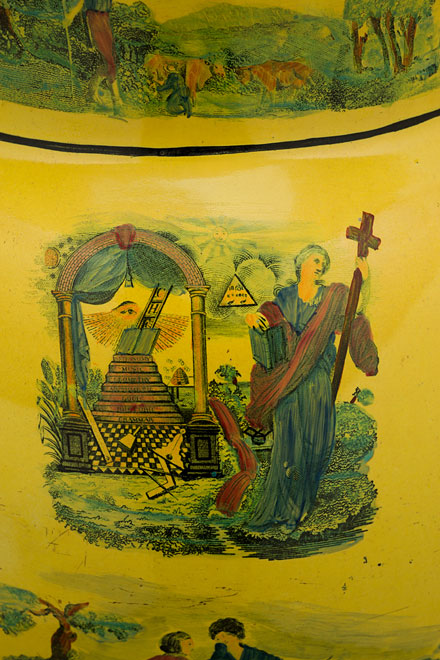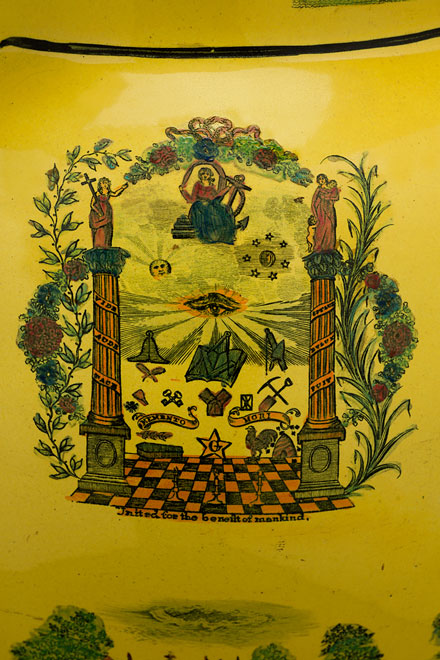
A recent addition to Historic Deerfield’s English ceramics collection aptly illustrates that ceramics were not confined solely to tableware or decorative forms in the 18th and 19th centuries, but could be utilized for a variety of purposes. The item—an oversized (height: 17 in.), earthenware, yellow-glazed jug with numerous unsigned transfer printed images (Fig. 1)—was likely used not to hold liquid or to serve beverages, but rather for advertising.[1]
While lacking the name of a specific shop, the jug’s sizeable dimensions suggests that it was placed in the window of a store which sold ceramic wares.[2] For example, one oversized jug in the collection of the Winterthur Museum inscribed “OXFORD. / Wholesale & Retail, / Warehouse.” was undoubtedly placed in the china merchant’s storefront window to advertise the name of the seller and to attract the attention of prospective buyers.[3] Also, with literacy being far from universal in 18th-century England, the jug’s size and placement would have left onlookers with little doubt about the merchant’s wares. Moreover, the number of transfer prints on the jug’s exterior suggests that it may have sat inside of a shop and been used to showcase the variety of images one could have printed on smaller ceramic wares.[4]


Of the 16 transfer prints ornamenting the jug (some of which are duplicates) several are Masonic in nature (Fig. 2).[5] As Sharon Greene explains, “Freemasonry was another source for decorative motifs on ceramics, particularly during the late eighteenth and early nineteenth centuries,” and the appearance of Masonic motifs on English ceramics of the period may have reflected the public’s curiosity with the fraternal organization.[6] Greene goes onto explain that Masons were not allowed to share the meanings of the various symbols associated with their group to non-members, “and consequently the unveiling of these secrets became an obsession with the public.”[7] In fact, one poem, titled “The Entered Apprentice’s Song” and printed on an oversized jug in the collection of the Shelburne Museum (Shelburne, Vermont), is used by Greene to illustrate the public’s fascination with Free Masonry:
MASONRY UNIVERSAL
The World is in Pain
Our secrets to gain
But still let them wonder and guess
For they ne’er can devine [sic]
The Word or the Sign
Of a Free and an Accepted Mason[8]
In addition to its size, the bright yellow color—created by adding antimony to the glaze mixture—was intended to appeal to onlookers.[9] While certain English slip wares and Chinese porcelains have been cited as possible design sources for English yellow-glazed earthenware, one intriguing theory points to the molded examples of fruit, produced ca. 1760 by Josiah Wedgwood, decorated with bright yellow and green glazes.[10] According to Wolf Mankowitz, Wedgwood produced these unique colorful glazes out of a desire to remedy the waning Staffordshire earthenware market of the 18th century.[11] Based on Wedgwood’s decision to produce these colorful glazes, Jack Leon writes it may have been a “hard-headed business motivation” that lead to the production of ceramics with an overall yellow glaze.[12] Leon continues by theorizing “that the inception and continued production of the overall yellow-glazed earthenwares is explicable in terms of an attempt to produce an appealing, colourful product that would sell well at home and abroad.”[13]
Despite its production by a number of English potteries, yellow-glazed earthenware appears not to have been created in large quantities. To help explain this, some scholars have suggested the wares’ general lack of popularity, while others cite technical difficulties associated with applying an overall consistent yellow glaze.[14]
As an object that naturally attracts attention and inspires questions and speculation, the jug is a welcome addition to Historic Deerfield’s extensive ceramics collection. Moreover, its addition allows museum staff not only to discuss an important decorative innovation in the history of English earthenwares, but also how ceramics and ceramic decoration were marketed to the general public.
[1] Sharon D. Greene, “Oversized Staffordshire Jugs,” The Magazine Antiques 149, no. 1 (1996): 192. A similar, but not identical, oversized jug from the collection of Doris and Stanley Tananbaum is owned by Colonial Williamsburg.
[2] Greene, “Oversized Staffordshire Jugs,” 192.
[3] S. Robert Teitelman, Patricia A. Halfpenny, Ronald W. Fuchs II, Wendell D. Garrett, and Robin Emerson, Success to America: Creamware for the American Market: Featuring the S. Robert Teitelman Collection at Winterthur (Woodbridge, Suffolk: Antique Collectors’ Club, 2010), 116.
[4] Ibid.
[5] Two of the Masonic prints found on the jug appear to have been common patterns, as they can be found printed on other ceramic forms. The print containing an image of a woman seated on a suspended platform between two columns and holding an anchor is similar to prints found on two separate creamware jugs in the collection of Historic Deerfield (HD 81.065 and HD 1999.24.1). The print of the gentleman sitting between two columns supporting globes is similar to a print found on another creamware jug at Historic Deerfield (HD 2014.19.6).
[6] Greene, “Oversized Staffordshire Jugs,” 200. Creamware pitchers with Masonic-themed transfer prints were also utilized in Masonic lodges. For an excellent discussion of transfer-printed pitchers and their use in Masonic lodges, see Hilary Anderson Stelling, “Ambassadors of Elegance: English Transfer-Printed Presentation Pitchers in Massachusetts Lodges,” in Reflections on 300 Years of Freemasonry, ed. Dr. John S. Wade (London: Lewis Masonic, 2017), 291-307.
[7] Greene, “Oversized Staffordshire Jugs,” 200.
[8] Quoted in Greene, “Oversized Staffordshire Jugs,” 200.
[9] J. Jefferson Miller II, English Yellow-Glazed Earthenware (Washington, D.C.: Smithsonian Institution Press, 1974), 5.
[10] Jack L. Leon, “Yellow-Glazed English Earthenware” English Ceramic Circle Transactions 8, no.1 (1971): 31-32.
[11] Ibid., 32. See also Wolf Mankowitz, Wedgwood (London: B.T. Batsford Ltd., 1953), 30-33.
[12] Leon, “Yellow-Glazed English Earthenware,” 32.
[13] Ibid.
[14] Miller, English Yellow-Glazed Earthenware, 6; Leon, “Yellow-Glazed English Earthenware,” 33.